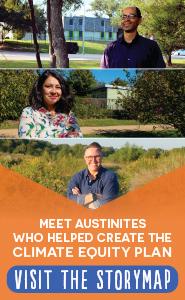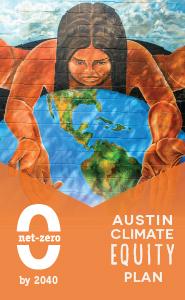Read the Translated Climate Equity Plan Summary Document
Español | Tiếng Việt | 中文 (简体) | 한국어 | Burmese | اُردُو | العربية | हिंदी | English
Net-zero by 2040, equitably.
In September 2021, City Council adopted the Austin Climate Equity Plan. The plan includes the bold and aggressive goal of equitably reaching net-zero community-wide greenhouse gas emissions by 2040 with a strong emphasis on cutting emissions by 2030. Getting to net-zero means the Austin community would reduce our use of fossil fuels to nearly zero. We set this goal because we believe it is possible and know it is needed to preserve a livable climate.
Be part of the bigger picture!
Watch the video to learn more about the goals of the Climate Equity Plan and ways that you can get involved.
Learn more about:
Creating the Plan | Implementing the Plan | What's in the Plan
Creating the Austin Climate Equity Plan
Climate change affects everyone, but the impacts are not felt equally among all communities. Low-income communities and communities of color are disproportionately burdened. To help address these disparities, we created the plan through the lens of racial equity and attempted to learn from people in our community while exploring solutions to the climate crisis.
What is your vision for Austin and the implementation of the Climate Equity Plan?
"That it stays community-inclusive, includes us every step of the way, and treats climate equity as the urgent issue that it is. The climate is changing and we need action now."
Austin's Climate Equity Plan was created with input from nearly 200 community members with an intentional focus on engaging racially and economically diverse residents about the challenges, barriers, and opportunities facing historically excluded groups. Community Climate Ambassadors were mobilized to engage members of our community on climate-related topics and provide feedback on potential strategies. Additionally, each strategy in the plan was evaluated through an equity tool that accounted for outcomes related to health, affordability, accessibility, community capacity, cultural preservation, accountability, and a just transition to green jobs.
Implementing the Plan
Successfully implementing the Climate Equity Plan will require collective awareness, action, and participation from all members of the Austin community. Since the plan’s adoption in September 2021, the City and its partners have been strategizing on how to further the plan’s 17 goals and 75 strategies.
.png) How we're moving forward...
How we're moving forward...-
Reporting & Metrics
- The Climate Equity Plan Dashboard includes information about the status of all 74 strategies in the plan.
- Data on Austin’s Community Carbon Footprint measures our community’s progress toward reaching net-zero emissions by 2040.
Amplifying Community Action
- The first Community Climate Ambassadors helped offer feedback during the plan’s creation. The new Ambassadors cohort will support the plan’s implementation by working on Community Action Projects.
- The Austin Green Business Leaders Program recognizes local businesses that are protecting the environment and making a difference in the Austin community. During the plan’s adoption, 51 Austin-area businesses pledged their support.
- In partnership with EcoRise, the Austin Youth Climate Equity Council helps engage area high school students around climate action and the Climate Equity Plan.
Focusing on Equity
- The Climate Equity Plan was built through a community co-creation process through the lens of racial equity. To help ensure equity during implementation, a Community Implementation Task Force is being assembled to collaborate with City staff on an Equity Metrics Project.
Funding
- There are many City of Austin departments working on climate action across the organization. For the City's 2022-23 budget, staff included a list of projects and funding amounts related to the plan.
Communications & Getting Involved
- A StoryMap was created to tell the story of the plan’s creation and the community members who helped make it happen. To help promote the plan, several video projects are currently in the works.
- A monthly Net-Zero Hero series on the Sustainable Austin blog tells the stories of regular Ausinities taking action on climate change.
- Austinites can stay up-to-date on what’s happening with the plan by subscribing to our newsletter or following us on Facebook.
- Learn more about how to get involved and take action.
What's in the Plan
Focus Areas, Goals, and Strategies
Clear and specific actions are required to move us toward our 2040 net-zero goal. The Austin Climate Equity Plan sets goals across five focus areas: Sustainable Buildings, Transportation and Land Use, Transportation Electrification, Food and Product Consumption, and Natural Systems.
Learn more about each of the Climate Equity Plan's focus areas and goals below, read a summary of the plan (PDF, 4.6 MB), or read the full plan (PDF, 10.8 MB).
 Overarching Strategies
Overarching Strategies-
Green Jobs and Entrepreneurship
Create green jobs and entrepreneurship opportunities that expand economic opportunity and inclusion, and build agency and decision-making power in low-income communities and communities of color.
Prioritize Local Community Initiatives
Prioritize and support existing community-led organizations, businesses, and programs while working to build a green and just economy and culture.
Regional Collaboration
Foster regional collaboration by creating a Texas Climate Collaborative, which will link neighboring counties and peer cities from across the state to share best practices and climate strategies.
Local Carbon Reduction Projects, Carbon Dioxide Removal, and Carbon Offsets
Establish clear support and prioritization for local greenhouse gas reduction and carbon removal projects, carbon dioxide removal, and carbon offsets when necessary.
 Sustainable Buildings
Sustainable Buildings-
About
Buildings in Austin are responsible for about 50% of our emissions. We can make strides in reducing our building-related emissions by decarbonizing buildings, addressing refrigerant use and leakage, and more sustainably managing construction materials. But improving our buildings isn’t just about reducing emissions. It’s also important to address indoor air quality and the energy cost of using our homes and commercial spaces. The following 2030 goals are intended to make buildings more sustainable in Austin while increasing equity.
2030 Goals
- All new buildings are net-zero carbon, emissions from existing buildings are reduced by 25%, and all natural gas-related emissions are reduced by 30%.
- Community-wide emissions from refrigerant leakage are reduced by 25%.
- The embodied carbon footprint of building materials used in local construction is reduced by 40%.
- A community-wide water demand of approximately 152,000 acre-feet per year is equitably achieved.
More Info
Read the Plan's full Sustainable Buildings section. (PDF, 745 KB)
 Transportation and Land Use
Transportation and Land Use-
About
Where our residents live, work, and play and how they move around our city greatly impact our communitywide emissions. Coordinated transportation and land use strategies combined with intentional anti-displacement strategies can improve access to greener forms of transportation, create more affordable housing, and reduce greenhouse gas emissions while supporting diverse communities. Our vision is to cultivate a person-centered mobility network that meets the needs of low-income communities and communities of color of all ages and abilities.
Goals
- 80% of new non-residential development is located within the city’s activity centers by 2030.
- 135,000 housing units are preserved and produced by 2027, including 60,000 affordable housing units, with 75% of new housing located within a half mile of the city's activity centers.
- By 2030, 50% of trips in Austin are made using public transit, biking, walking, carpooling, or avoided altogether by working from home.
More Info
Read the Plan's full Transportation and Land Use section. (PDF, 523 KB)
 Transportation Electrification
Transportation Electrification-
About
In Austin, our transportation system will soon become the largest emitter of greenhouse gases and is already the primary source of local air pollution. The vast majority of these transportation-related emissions are caused by private cars and trucks. This means that to meet our emissions reduction targets, we will need to have more people using sustainable forms of transportation, including private vehicles powered by renewable energy. The good news is that electric vehicles (EVs) are becoming more affordable and have a longer range, and more charging options are available. The following goals for 2030 aim to increase community adoption of EVs.
2030 Goals
- 40% of total vehicle miles traveled in Austin are electrified, and EV ownership is culturally, geographically, and economically diverse.
- Austin has an equitably distributed mix of level 1, 2, and DC fast-charging stations to support more EVs on the road.
- The Austin-Round Rock-San Marcos area is a leader in transportation electrification through policies and technologies that support the growth of this emerging industry.
More Info
Read the Plan's full Transportation Electrification section. (PDF, 1 MB)
 Food & Product Consumption
Food & Product Consumption-
About
To fully account for the emissions of the food and products we consume, we need to consider the raw material extraction, consumption, and eventual disposal or reuse of a product—regardless of where those activities occur. Many of the products we consume locally have a global emissions impact. When it comes to the goods and foods we consume, we can create more efficient, circular processes that improve quality of life and restore human and planetary health. The following goals are meant to get us closer to this vision by 2030.
2030 Goals
- All Austinites can access a food system that is community-driven, addresses food insecurity, prioritizes regenerative agriculture, supports dietary and health agency, promotes plant-based foods, and minimizes food waste.
- Greenhouse gas emissions from institutional, commercial, and government purchasing are reduced by at least 50%.
- Waste reduction, organics composting, and recycling are aggressively pursued to achieve the waste reduction goals in the 2023 Austin Resource Recovery Comprehensive Plan.
More Info
Read the Plan's full Food & Product Consumption section. (PDF, 787 KB)
 Natural Systems
Natural Systems-
About
Natural systems are all around us. They are the plants, soils, hydrology, geology, weather patterns, and animals that are interlinked to ensure the overall health of our ecosystem. Natural systems also perform the important job of removing carbon from the atmosphere, known as carbon sequestration. They offer a multitude of health and quality of life benefits for our residents. Protecting and preserving our natural systems is an investment in our community’s health, livelihood, and culture.
Goals
- By 2030, 20,000 additional acres of carbon pools on natural lands are protected, and all natural areas are managed with a focus on resilience.
- 500,000 acres of farmland in the five-county region are protected through legal conservation or regenerative agriculture programs by 2030.
- At least 50% citywide tree canopy cover is achieved by 2050, focusing on increasing canopy cover equitably.
- By 2030, all City-owned lands are included under a management plan that results in neutral or negative carbon emissions and maximizes community benefits.
More Info
Read the Plan's full Natural Systems section. (PDF, 1.2 MB)
More info
- Learn about climate change.
- Read the Austin Climate Equity Plan Summary Document (PDF, 4.6 MB).
- Explore the full Austin Climate Equity Plan (PDF, 10.8 MB).
- Visit the Austin Climate Equity Plan StoryMap to learn more about our process and strategies.
- Learn about how the plan is being implemented at the Climate Equity Plan Dashboard.
Get involved
- Sign up to receive our newsletter to get the latest updates.
If you'd like to explore other ways to get involved, please contact our team.



